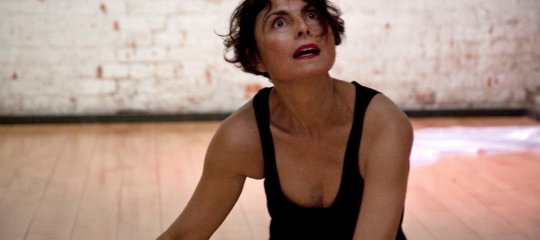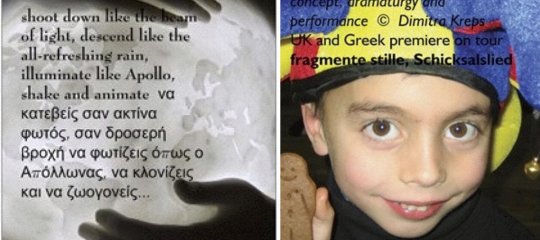Ο Αρκάς στα ιταλικά
sissiatha writes, "Η μετάφραση της σειράς "χαμηλές πτήσεις" του γνωστού Έλληνα γελοιογράφου έγινε αφορμή για μια συνολικότερη συζήτηση που αφορά στη σύγχρονη ελληνική πραγματικότητα, την τόσο άγνωστη στους Ιταλούς.
Τα μαθήματα νέας ελληνικής αποτέλεσαν, κατά κάποιο τρόπο, την αφορμή αυτής της έκδοσης. "
Οι φωτογραφίες είναι από την παρουσίαση του Αρκά στη διεθνή αλυσίδα βιβλιοδισκοπωλείων Fnack, στα μέσα του περασμένου μήνα
24 Οκτωβρίου 2005
Ο ΑΡΚΑΣ ΣΤΑ ΙΤΑΛΙΚΑ
 Κυκλοφόρησε το Σεπτέμβριο το τρίτο κι ετοιμάζεται η έκδοση του τέταρτου τεύχους της σειράς χαμηλές πτήσεις του Αρκά, στα ιταλικά. Την ιταλική έκδοση ανέλαβε εκδοτικός οίκος της περιοχής της Νάπολης, δίνοντας έτσι την ευκαιρία στους Ιταλούς αναγνώστες να έρθουν, για πρώτη φορά, σε επαφή με την ελληνική γελοιογραφική τέχνη. Την πολύ πετυχημένη, καθ’ ομολογίαν όλων, μετάφραση έκανε η Priscilla Maddaloni, που σπούδασε ελληνικά στο Πανεπιστήμιο της Νάπολης αλλά και στην Θεσσαλονίκη και τα Γιάννενα, όπου βρέθηκε ως υπότροφος του ελληνικού κράτους.
Κυκλοφόρησε το Σεπτέμβριο το τρίτο κι ετοιμάζεται η έκδοση του τέταρτου τεύχους της σειράς χαμηλές πτήσεις του Αρκά, στα ιταλικά. Την ιταλική έκδοση ανέλαβε εκδοτικός οίκος της περιοχής της Νάπολης, δίνοντας έτσι την ευκαιρία στους Ιταλούς αναγνώστες να έρθουν, για πρώτη φορά, σε επαφή με την ελληνική γελοιογραφική τέχνη. Την πολύ πετυχημένη, καθ’ ομολογίαν όλων, μετάφραση έκανε η Priscilla Maddaloni, που σπούδασε ελληνικά στο Πανεπιστήμιο της Νάπολης αλλά και στην Θεσσαλονίκη και τα Γιάννενα, όπου βρέθηκε ως υπότροφος του ελληνικού κράτους.
Έχει ίσως κάποιο ενδιαφέρον ότι η μεταφράστρια γνώρισε τον Αρκά, μέσα από τα πανεπιστημιακά μαθήματα της νεοελληνικής και βέβαια εμβάθυνε στο έργο του με προσωπική αναζήτηση και διάβασμα. Κι ακόμη το ότι αυτή είναι η πρώτη φορά που μεταφράζεται έργο Έλληνα γελοιογράφου στα ιταλικά.
Η Priscilla προσέγγισε το κείμενο με σεβασμό αλλά και την απαραίτητη ελευθερία προκειμένου να το κάνει λειτουργικό και για τον Ιταλό αναγνώστη. Η ευχέρειά της εξάλλου στη χρήση της ελληνικής και το ταλέντο της τής επέτρεψαν να πάρει τις απαραίτητες πρωτοβουλίες, χωρίς να προδώσει το πνεύμα και το στυλ του δημιουργού.
Η αγάπη με την οποία προσέγγισαν το έργο, μεταφράστρια κι εκδότες, είναι εμφανής. Φάνηκε να το διασκεδάζουν πρώτα αυτοί και την ευφορία τους θέλησαν να τη μεταδώσουν και σε μας. Είναι, πιστεύω, αυτός ο καλύτερος λόγος για να μπει κανείς στην περιπέτεια της μετάφρασης. Η επιλογή τους ήταν εξαιρετικά οξυδερκής, μια και από όλους τους Έλληνες γελοιογράφους, επιλέχτηκε ο πιο, ας τον χαρακτηρίσουμε έτσι, διεθνής.
Η σύγχρονη Ελλάδα έχει εξαίρετους γελοιογράφους. Όχι τυχαία φαντάζομαι. Το παρόν και το παρελθόν μας είναι γι’ αυτούς πηγή διαρκούς έμπνευσης. Η προσκόλληση όμως στην ελληνική πραγματικότητα τους κάνει, πιθανόν, λιγότερο κατανοητούς στο διεθνές κοινό. Η συγκεκριμένη έκδοση ανοίγει το δρόμο για την γνωριμία με το έργο των Ελλήνων γελοιογράφων γενικότερα κι αποκαλύπτει μια άλλη εικόνα της σύγχρονης Ελλάδας, διαφορετική από τη γνωστή τουριστική κι αποτελεί μια πρόκληση για τις ελληνικές σπουδές στην Ελλάδα και στο εξωτερικό.
Αυτό εξάλλου τόνισαν πανεπιστημιακοί και διανοούμενοι σε πρόσφατη παρουσίαση του έργου, σε αίθουσα εκδηλώσεων στο κέντρο της πόλης.
Σίσσυ Αθανασοπούλου

- Εισέλθετε στο σύστημα για να υποβάλετε σχόλια










